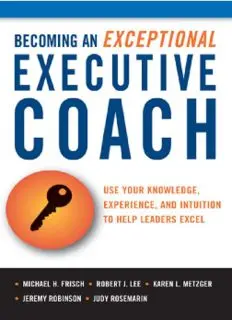
Becoming an Exceptional Executive Coach: Use Your Knowledge, Experience, and Intuition to Help Leaders Excel PDF
Preview Becoming an Exceptional Executive Coach: Use Your Knowledge, Experience, and Intuition to Help Leaders Excel
Becoming an Exceptional Executive Coach USE YOUR KNOWLEDGE, EXPERIENCE, AND INTUITION TO HELP LEADERS EXCEL Michael H. Frisch, Robert J. Lee, Karen L. Metzger, Jeremy Robinson, and Judy Rosemarin AMERICAN MANAGEMENTASSOCIATION NewYork•Atlanta•Brussels•Chicago•MexicoCity•SanFrancisco Shanghai•Tokyo•Toronto•Washington,D.C. AmericanManagementAssociation•www.amanet.org Bulkdiscountsavailable.Fordetailsvisit: www.amacombooks.org/go/specialsales Orcontactspecialsales: Phone:800-250-5308 Email:[email protected] ViewalltheAMACOMtitlesat:www.amacombooks.org Thispublicationisdesignedtoprovideaccurateandauthoritativeinformation inregardtothesubjectmattercovered.Itissoldwiththeunderstandingthatthe publisherisnotengagedinrenderinglegal,accounting,orotherprofessional service.Iflegaladviceorotherexpertassistanceisrequired,theservicesofa competentprofessionalpersonshouldbesought. LibraryofCongressCataloging-in-PublicationData Becominganexceptionalexecutivecoach:useyourknowledge,experience,andintuitionto helpleadersexcel/MichaelH.Frisch...[etal.]. p.cm. Includesbibliographicalreferencesandindex. ISBN-13:978-0-8144-1687-7 ISBN-10:0-8144-1687-X 1. Executivecoaching. I.Frisch,MichaelH. HD30.4.B432011 658.4’07124—dc22 2011011577 © 2012MichaelH.Frisch,RobertJ.Lee,KarenL.Metzger,JeremyRobinson,and JudyRosemarin. Allrightsreserved. PrintedintheUnitedStatesofAmerica. Thispublicationmaynotbereproduced,storedinaretrievalsystem,ortransmittedinwhole orinpart,inanyformorbyanymeans,electronic,mechanical,photocopying,recording,or otherwise,withoutthepriorwrittenpermissionofAMACOM,adivisionofAmerican ManagementAssociation,1601Broadway,NewYork,NY 10019 AboutAMA AmericanManagementAssociation(www.amanet.org)isaworldleaderintalentdevelop- ment,advancingtheskillsofindividualstodrivebusinesssuccess.Ourmissionistosupport thegoalsofindividualsandorganizationsthroughacompleterangeofproductsandservices, includingclassroomandvirtualseminars,webcasts,webinars,podcasts,conferences,corpo- rateandgovernmentsolutions,businessbooksandresearch.AMA’sapproachtoimproving performancecombinesexperientiallearning—learningthroughdoing—withopportunities forongoingprofessionalgrowthateverystepofone’scareerjourney. Printingnumber 10987654321 AmericanManagementAssociation•www.amanet.org Contents Acknowledgments v List of Figures vi Introduction 1 PART I: FOUNDATIONS FOR BECOMINGAN EXCEPTIONAL EXECUTIVE COACH 7 Chapter 1 Your Personal Model of Coaching 9 Chapter 2 Executive Coach Competencies 19 Chapter 3 Foundations and Definitions 24 PART II: TOPICS IN EXECUTIVE COACHING 39 Chapter 4 Managing the Coaching Engagement 41 Chapter 5 Contracting the Coaching Process with Clients and Sponsors 54 Chapter 6 Sponsor and Stakeholder Involvement 63 Chapter 7 Building Early Relationships with Clients 75 Chapter 8 Goal Evolution 86 Chapter 9 Assessment and Information Gathering 94 Chapter 10 Feedback:What and How 106 Chapter 11 Development Planning 117 Chapter 12 Encouraging Dialogue and Stories 127 Chapter 13 Strengthening the Partnership 137 Chapter 14 Using the Partnership to Motivate Change 145 ————iii AmericanManagementAssociation•www.amanet.org CONTENTS Chapter 15 Coaching for Leadership 153 Chapter 16 Differences 166 Chapter 17 Closure 176 Chapter 18 What Happened:Self-Reflection and Evaluation 188 Chapter 19 Professionalism and Responsibility 198 Chapter 20 The Role of the Internal Coach 208 PART III: ARTICULATINGTHE OUTPUTS OFYOUR PERSONAL MODEL 219 Chapter 21 Output 1:YourApproach to Executive Coaching 221 Chapter 22 Output 2:Your Executive Coaching Practice 229 Chapter 23 Output 3:Your Professional Development Plan 235 Chapter 24 Becoming an Exceptional Executive Coach: Amber’s Story 239 Exhibits 249 Notes 269 Coaching Glossary 271 For Further Reading 273 Index 276 About theAuthors 281 iv———— AmericanManagementAssociation•www.amanet.org Acknowledgments First,wewouldliketothankanearlybutpivotalcontributortothereal- ization of this book. At the 2008 annual meeting of the American PsychologicalAssociation,RichardHackmangaveapresentationabout the dos and don’ts of producing a book based on topically focused discussions of a long-standing group of colleagues. We don’t know whatotherattendeesatthatsessiontookaway,butforusthemessages were clear: Turning intentions and interesting points into tangible text requiresthetyrannyofaprojectmanager,duedates,funds,andapro- fessionaleditor.Justasincoaching,asolidprocessthatputsideasinto actionisanecessaryconditionforaspirationstobecomereality. More immediately, we would like to thank our students, super- visees, and the organizational sponsors of coaching assignments con- nected with our courses. During our ten years of teaching executive coaching,theirsupportandencouragementhaveprovideduswiththe impetus to continually question, refine, and articulate our ideas about executive coaching. We would also like to thank our organizational clients,whohavereliedonustosupporttheirinternalcoachingefforts, as well as our academic partners, Baruch College (CUNY) Zicklin Business School’s Management Department and the graduate pro- gramsoftheNewSchoolUniversity.Inaddition,wewouldliketothank our editor, Claire Wyckoff, who participated in innumerable “book” meetings, showing enormous patience in providing guidance on both the product and the process. We would also like to thank Christina Parisi, our Executive Editor at AMACOM, who supported our proposal and was decisive in helping us resolve key questions even as she nur- tured her other projects. Finally, we would like to thank our families, who unflinchingly supported this extracurricular effort with their encouragementandflexibility. ————v AmericanManagementAssociation•www.amanet.org List of Figures Figure1-1. PersonalModelinputsandoutputs. p. 12 Figure2-1. Coachcompetencies. p. 21 Figure3-1. Streamsandbanksofexecutivecoaching. p. 26 Figure3-2. Executivecoachingcontinuum. p. 35 Figure4-1. Typicalphasesofexecutivecoaching. p. 42 Figure5-1. Contracting:settingprocessexpectations. p. 56 Figure7-1. Guidelinesforthefirstcoachingsession. p. 78 Figure7-2. Sessionstructure. p. 80 Figure8-1. Goalevolution. p. 87 Figure9-1. Popular360-degreefeedbackinstruments. p. 96 Figure9-2. Introductiontotheinformationalinterview. p. 99 Figure11-1. Benefitsofdevelopmentplanningmeetings. p. 121 Figure13-1. Containmentequation. p. 138 Figure14-1. Reframingresistance. p. 148 Figure16-1. Self-assessmentaboutdifferences. p. 169 Figure16-2. Differencesdecisiontree. p. 172 Figure19-1. Coachingcaveats. p. 200 Figure20-1. Internalcoachconsiderations. p. 213 vi———— AmericanManagementAssociation•www.amanet.org Introduction Our Journeys Wefiveauthorscametoexecutivecoachinginwayssimilartothosewhopar- ticipateinourcoachtrainingcourses—fromorganizationalpsychology,con- sulting, organization development, career counseling, and the personal helpingprofessions.Atthetimewebegantocoachtherewasnoformalprac- ticeofexecutivecoaching.Theneedforindividualized,just-in-timeexecu- tivedevelopmentemergedinthe1980s,intheformofrequestsforhelpfrom ourhumanresourcescontacts.TakingacuefromAChorusLine,amusicalof thatera,werespondedwith,“Wecandothat!”Withverylittledefinitionor guidance, we originally provided those individual development services under various headings, such as developmental counseling, mental health consultation,occupationalclinicalpsychology,orretentionwork.Bytheearly 1990s, however, executive coaching had become the preferred label, and somewhatconsistentexpectationshadbeendefined. Although there was no training for executive coaches back then, there weremanystreamsofskill,knowledge,andpracticethatfueledandshaped coaching work, including individual psychotherapy, leadership develop- mentcourses,organizationdevelopment(OD),andhumanresourcescon- ————1 AmericanManagementAssociation•www.amanet.org INTRODUCTION sulting. At the same time, there were new ideas about management and leadership that were synergistic with the increasing demand for executive coaching. Managerial competencies beyond technical skills were gaining prominence,includinganemphasisonthemanagerascoachanddevelop- eroftalent.Approachestoleadershipbeganfocusingonsoftskillareassuch ascommunicationandinterpersonaldynamicsratherthanformalauthori- ty or command and control. Human resources practices were moving beyondpersonneladministrationtoincludesophisticatedsuccessionplan- ning systems and 360-degree feedback tools for individual development. Consultingandtrainingfirmsandexecutiveeducationbranchesofbusiness schoolswererespondingto,andadvancing,thesenewideasaboutleader- shipandHRpracticesandincorporatingthemintomanagementandexec- utivetrainingexperiencesforclients. Ourearlyopportunitiesforexecutivecoachingworkevolvedoutofthose swirlingapplications.Undertheprevailingzeitgeist,executivecoachingcoa- lescedwithasurprisingdegreeofconsistencyaroundaconfidentialone-on- onerelationship,informedby360-degreeandotherassessments,organiza- tionally sponsored, and anchored in on-the-job action planning. Certainly there were branded labels for coaching, reflecting a particular theoretical model or the desire to be differentiated in the marketplace, but the rough outlines of accepted executive coaching practice became clear quickly. Supportingthatclaritywasthefactthatcoachingwasnotyetatermusedfor servicesoutsideoforganizationalcontexts.Inotherwords,thetermcoaching hadnotyetballoonedtoapplytopersonal,life,andcareerinterventions. Bytheearly1990sintheUnitedStates,coachinghadbecomeanaccepted optionforexecutivedevelopment.Eventhosefirmsofferingmoretraditional classroomcoursessawcoachingasacomplementtotheireffortsandgraftedit on. The Center for Creative Leadership was an early innovator in executive developmentcoursesandusedcoachingtofacilitateinterpretationofassess- ment feedback as a basis for individual development planning. In addition, coachingfounditswayintoincreasinglysophisticatedhumanresourcesprac- tices. Competency-driven human resource planning, performance manage- mentsystems,andactionlearningteamsalltriggeredidentificationofleaders 2———— AmericanManagementAssociation•www.amanet.org INTRODUCTION who would benefit from individualized, accelerated development. As execu- tives and managers were selected for development, demand for coaching grew. Coaches were screened, introduced to prospective clients, and offered coachingopportunities,typicallyforsix-monthengagements. In these early years, coaching qualifications were undefined, but some werefavored:affinityforthebusinessenterprise;insightaboutorganizational life,especiallyatthetop;theabilitytoengageexecutivesone-on-oneinaself- discoveryprocess;andorganizationalsponsormanagement.Industry-specific knowledge,assessmenttoolfacility,professional/humanresourcesnetworks, andconsultingexperiencewerealsoimmediatelyuseful.Experienceasapro- fessionalcounselorandadvancedtraininginpsychologyorotherhumanserv- icefieldsaddedtocredibilitybutwerenotrequired.Eventually,aparallelphe- nomenon emerged as HR professionals began offering forms of coaching to managersintheirorganizations,andtheroleoftheinternalcoachwasborn. Theauthorsparticipatedactivelyinthegrowthofexecutivecoachingand alsowerecalledupontohelpimproveitspractices.Startinginthemid-1990s, wesupportedthedevelopmentandcasesupervisionoflessexperiencedexec- utivecoaches.Forallofus,thesecasesbecameverygratifyingaspectsofour professional lives. We discovered we enjoyed, and were effective at, guiding othersintheircoachingwork.Wealsofoundasynergybetweencoachingthe coach and our own coaching practices: Our cases became opportunities to extractlessonsandprovideexamples,whilethecasesourstudentsprovided drewusintobroadercoachingissuesandconsiderationsofhowtotraincoach- es, whether they would be based inside their home organization (internal coaches)orbecomeindependentcoachesofferingtheirservicestoavarietyof organizations(externalcoaches). Key Principles from Our Executive Coach Training Programs Theseexperiencesledustodelivercoursesonexecutivecoachingstartingin 2002.Sincethen,wehaverefinedandclarifiedourideasaboutcoachingand howcoacheslearn.Theseinsightsarethebasisforthedesignandcontentof ————3 AmericanManagementAssociation•www.amanet.org
